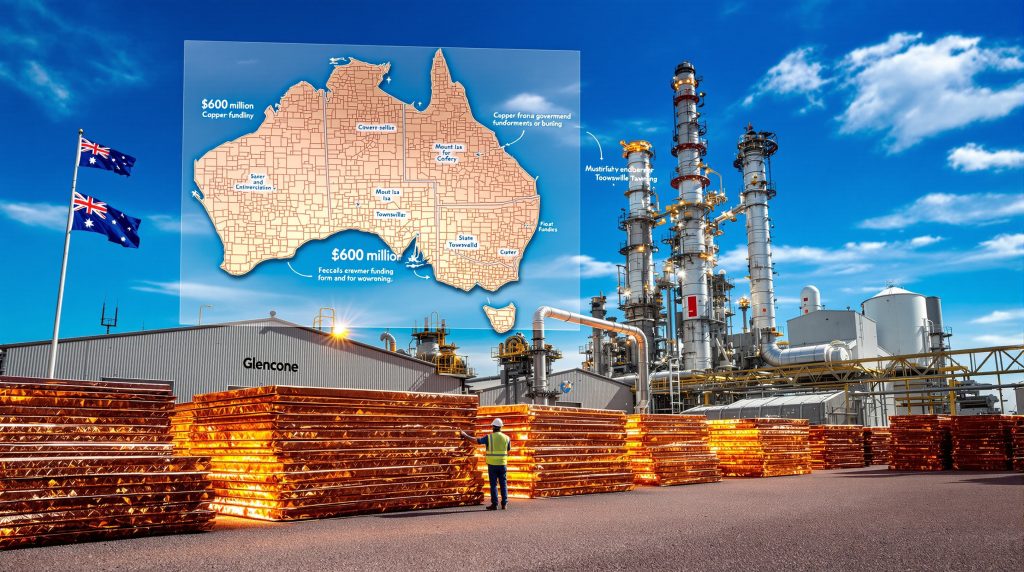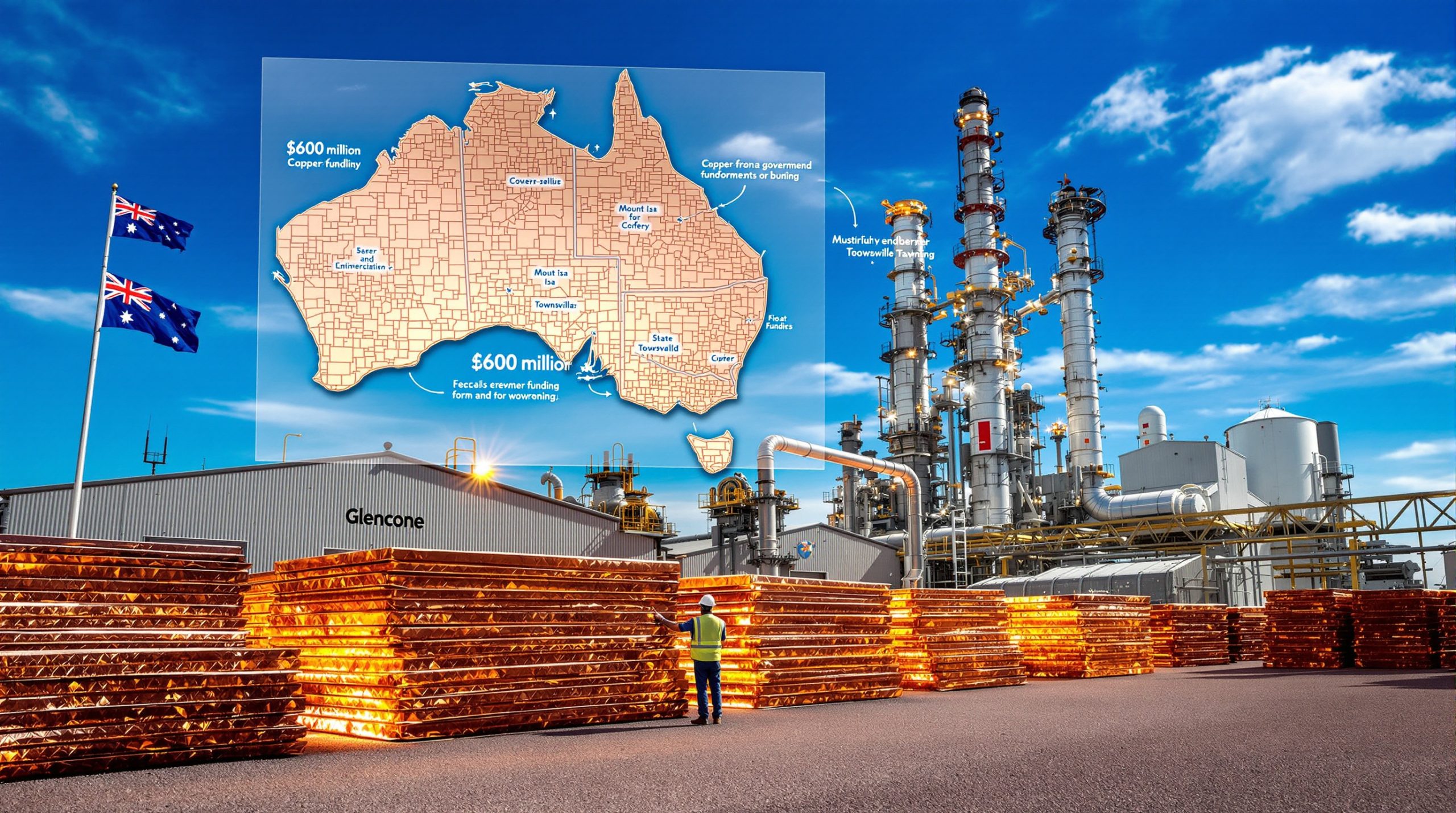What Is the $600 Million Taxpayer Support Package for Glencore?
The Australian and Queensland governments have jointly committed to a $600 million financial support package designed to maintain operations at Glencore's copper processing facilities in Queensland through the end of 2028. Announced in October 2025, this funding represents a significant investment in preserving critical mineral processing capabilities within Australia's borders.
The support package features a 50-50 cost-sharing arrangement between federal and state governments, with payments structured across three years. Two annual payments of $200 million each will be guaranteed, with a third $200 million payment contingent upon all parties meeting their contractual obligations.
This government intervention targets two strategically important facilities in Queensland's copper supply chain: the Mount Isa Copper Smelter in northwest Queensland and the Townsville Copper Refinery along the northeast coast. The smelter and refinery represent Australia's only integrated copper processing system capable of handling third-party copper concentrate.
Federal Minister for Industry and Innovation Tim Ayres confirmed the cost-sharing structure, emphasizing the conditional nature of the final payment to ensure accountability. The financial support follows months of negotiations after Glencore warned these facilities would transition into care and maintenance mode without assistance, effectively shutting down Australia's domestic copper processing capability.
This isn't the first time these facilities have received government support. In 2016, the Queensland government invested $15 million toward a $30 million rebricking operation at the smelter. The most recent multi-million-dollar rebrick was completed in 2022, with the next maintenance cycle due in 2026.
Why Are These Copper Facilities Strategically Important?
Critical Infrastructure for Australian Mining
The Mount Isa smelter holds unique strategic value as Australia's only facility capable of processing third-party copper concentrate. This processing capability creates a complete domestic supply chain that significantly benefits smaller mining operations throughout the region who depend on access to processing facilities.
This integrated processing system encompasses multiple stages: processing copper concentrate from both Glencore and third-party mines, rail transport of materials between Mount Isa and Townsville, production of up to 300,000 tonnes of pure copper cathode annually, and export operations through Townsville port.
Without this domestic processing capability, many smaller copper mining operations would face prohibitive costs to export raw concentrate overseas for processing, potentially making some projects economically unviable.
Employment and Regional Economic Impact
The copper operations directly support approximately 600 jobs between both facilities, with roughly 350 at the Mount Isa Copper Smelter and 250 at the Townsville Refinery. However, the economic impact extends far beyond direct employment.
According to Townsville Enterprise Chair Kevin Gill, approximately 17,000 regional jobs are connected to these operations when accounting for indirect employment through supply chains, port activities, rail transport, and related industries.
"There are about 17,000 jobs at risk if these operations were to cease," Gill stated, highlighting the significant regional economic dependencies on these facilities.
The employment impact is particularly significant in regional Queensland, where high-paying industrial jobs are crucial to maintaining community prosperity and population stability.
Strategic Materials Production
Beyond employment, these facilities produce materials critical to modern infrastructure, technology, and agriculture. The primary output—pure copper cathode—is essential for electrical wiring and cabling, with applications ranging from residential construction to renewable energy infrastructure.
The smelting process also generates valuable by-products, particularly sulphuric acid, which supports the Phosphate Hill fertilizer plant. This creates additional supply chain dependencies throughout Queensland's agricultural sector.
As copper price predictions continue to rise, particularly driven by renewable energy technologies and electric vehicles, the strategic value of domestic processing capability becomes increasingly significant.
What Economic Challenges Made Government Support Necessary?
Global Market Pressures
Glencore cited several factors making the facilities economically unviable without government support, with global market distortions playing a central role in undermining the competitiveness of Australian copper processing.
Refining charges have dropped dramatically as China and Indonesia have expanded their smelting capacity. This expansion, often supported by government subsidies and preferential policies in those countries, has created significant market distortion that Australian operations struggle to compete against.
The company pointed to North Queensland energy costs as a particular disadvantage, describing them as "double or more" than those in competing countries like India, China, Canada, and the United States. These elevated energy costs create a structural disadvantage for Australian processing operations that cannot be overcome through operational efficiencies alone.
Infrastructure Maintenance Requirements
The Mount Isa smelter faces significant periodic maintenance requirements that create additional financial pressure. The facility requires major maintenance including rebricking approximately 60,000 refractory bricks every four years, with the next cycle due in 2026.
This maintenance represents a major capital expenditure that becomes increasingly difficult to justify when the operation faces structural economic disadvantages in global markets. Without government support, Glencore indicated it would be unable to commit to this maintenance cycle, effectively meaning the facility would need to cease operations.
Previous Support History
The current support package continues a pattern of periodic government assistance for these strategically important facilities. In 2022, Glencore completed a multi-million-dollar rebrick of the smelter, extending its operational life.
In 2016, the Queensland Labor government invested $15 million toward a $30 million rebricking operation, recognizing even then the strategic importance of maintaining domestic processing capability despite challenging market conditions.
This history of periodic support reflects the ongoing tension between market economics and strategic national interests in critical minerals reserve processing.
How Is the $600 Million Support Package Structured?
Payment Schedule
The financial arrangement follows a carefully structured timeline designed to provide immediate certainty while ensuring accountability for all parties:
- Two annual payments of $200 million each (total $400 million) guaranteed to maintain operations
- A third payment of $200 million contingent on all parties meeting their obligations under the agreement
This structure provides Glencore with the certainty needed to commit to the next maintenance cycle while giving the government leverage to ensure compliance with operational and employment commitments.
Cost-Sharing Model
The funding responsibility is evenly divided between federal and state governments:
- Federal government: $300 million (50%)
- Queensland government: $300 million (50%)
This equal sharing reflects the multi-layered strategic importance of these facilities to both national and state interests, from maintaining critical minerals processing capabilities to preserving regional employment.
Glencore's Contribution
According to Troy Wilson, Glencore Metals Australia interim chief operating officer, the company had already made significant financial sacrifices before securing government support:
"[The agreement] comes after Glencore had already stepped up to absorb significant financial losses to maintain operations and jobs while working on a solution with government," Wilson stated.
The company's willingness to absorb operational losses while negotiating demonstrates its commitment to finding a sustainable solution, though critics might question whether taxpayers should be subsidizing a multinational corporation's operations.
What Are the Strategic Implications for Australia's Resource Sector?
National Resilience Considerations
Dr. John Coyne from the Australian Strategic Policy Institute highlighted several strategic dimensions to maintaining domestic copper processing capability:
"At the end of the day, the long-term predictions for copper are great, demand will increase," Coyne noted, pointing to copper's growing importance in renewable energy infrastructure and electric vehicles.
He emphasized that market competition is being artificially distorted: "Competition in the market is being distorted, with smelters in China being given cheap loans and access to inexpensive power."
Perhaps most significantly, Coyne highlighted the national resilience aspect: "If we don't protect at least some of our industry, we will lack the ability to support ourselves, in terms of national resilience."
This self-sufficiency concern has grown more prominent in policy discussions following supply chain disruptions during the COVID-19 pandemic, with increased focus on maintaining strategic manufacturing and processing capabilities domestically.
Competitive Positioning
The support package aims to maintain Australia's competitive position in global copper markets, particularly against countries that provide more substantial government support to their domestic industries.
China's expanding copper processing capacity benefits from government-backed financing and subsidized energy costs, creating an uneven competitive landscape. Indonesia has similarly invested in growing its domestic smelting operations, often with significant government support.
Meanwhile, the United States has increasingly focused on securing critical mineral supply chains through various policy mechanisms, recognizing their strategic importance to both economic prosperity and national security.
Australia's support package represents an effort to remain competitive in this changing landscape, ensuring the country retains not just mining capacity but also the value-added processing capabilities that create jobs and economic resilience.
What Regional Perspectives Exist on the Deal?
Mixed Regional Reactions
Local stakeholders have expressed varied perspectives on the funding arrangement, revealing the complex regional dynamics surrounding these operations.
Kevin Gill, Townsville Enterprise Chair, strongly supported the package, emphasizing its importance for regional employment: "There are about 17,000 jobs at risk if these operations were to cease."
Robbie Katter, State Member for Traeger, offered a more measured response, describing the funding as "a start" but emphasizing that more work remains to be done:
"Let's be clear, we're only at half time. There's no champagne and celebrations at half time, just a rev up from the coach to go out and finish the job in the premiership half," Katter stated.
He further emphasized the need for continued engagement: "We need them to remain at the negotiating table to reform the smelter operations, not just continually save it and leaving it in the hands of the one owner."
This perspective hints at deeper concerns about the long-term sustainability of the current ownership and operational model, suggesting that more fundamental reforms might be necessary.
Future Considerations
Key questions remain about the long-term viability of these operations beyond the three-year support period:
- Will the three-year extension provide enough time to implement structural changes that improve operational economics?
- Should the government consider more permanent solutions, such as partial ownership or restructured operational models?
- What happens after 2028 when this support package expires?
These questions reflect broader concerns about whether periodic government support represents a sustainable approach to maintaining strategic processing capabilities, or whether more fundamental changes to ownership structures, energy costs, or regulatory frameworks might be needed.
How Does This Compare to Previous Mining Industry Support?
Historical Context
Government support for resource processing has precedent in Australia, with various mechanisms used to maintain strategic capabilities during periods of market challenge:
- Previous funding for the Mount Isa smelter in 2016 and 2022
- Support packages for other strategic mineral processing operations facing similar competitive pressures
- State-level incentives for maintaining regional employment in resource sectors
These precedents illustrate the ongoing tension between free-market principles and strategic national interests in critical industries, particularly those facing market distortions from overseas competitors operating with different levels of government support.
Policy Justifications
The current support package reflects several policy priorities that extend beyond purely economic considerations:
- Maintaining domestic processing capability for critical minerals, particularly as global copper supply forecast shows increasing demand
- Supporting regional employment in Queensland, where these operations provide significant direct and indirect jobs
- Ensuring Australia remains competitive in global copper markets despite structural disadvantages
- Preserving strategic infrastructure that would be difficult and costly to replace or restart once shut down
These priorities reflect a recognition that market economics alone might not maintain capabilities that serve broader national interests, particularly when competing against countries with different approaches to government involvement in strategic industries.
What Does the Future Hold for Australian Copper Processing?
Short-Term Outlook
The immediate impact of the support package is clear:
- Operations secured until the end of 2028
- Planned maintenance including the 2026 rebricking will proceed
- Supply chains and employment preserved in the near term
- Continued production of copper cathode and sulphuric acid by-products
This provides valuable certainty for workers, related businesses, and the regional economy over the next three years, allowing time for broader strategic planning.
Long-Term Considerations
Fundamental questions about sustainability remain:
-
Structural competitiveness: Can Australian copper processing become economically viable without ongoing subsidies? This would likely require addressing energy cost disadvantages and finding ways to compete with heavily subsidized overseas operations.
-
Energy cost challenges: Will renewable energy investments help reduce the operating cost disadvantage? North Queensland has significant renewable energy potential that could potentially transform the economics of energy-intensive processing.
-
Global market positioning: How will Australia's copper investment insights adapt to continued expansion of processing capacity in China and Indonesia? Finding specialized niches or higher-value products might offer pathways to sustainable operations.
-
Strategic minerals policy: Should Australia develop a more comprehensive approach to supporting domestic processing of critical minerals, rather than addressing challenges facility-by-facility?
Comparing International Copper Processing Competitiveness
| Country | Energy Cost Advantage | Government Support | Processing Capacity | Market Share Trend |
|---|---|---|---|---|
| China | High (subsidized) | Extensive | Rapidly expanding | Increasing |
| Indonesia | Moderate | Growing | Expanding | Increasing |
| Australia | Low (2x competitors) | Periodic | Stable | Declining without support |
| United States | Moderate | Strategic investments | Stable | Stable |
| Canada | High | Varied by province | Stable | Stable |
This comparative landscape illustrates the challenging competitive position facing Australian copper processing facilities. Without addressing structural disadvantages, particularly in energy costs, or implementing more comprehensive government support policies, maintaining competitive operations will remain challenging.
What Are the Economic Implications of the Support Package?
Cost-Benefit Considerations
The $600 million investment must be evaluated against several factors that extend beyond direct financial returns:
- Preservation of approximately 17,000 direct and indirect jobs across regional Queensland
- Maintained tax revenue from workers and related businesses
- Continued export earnings from processed copper products
- Strategic value of domestic processing capability for national resilience
- Alternative costs of unemployment and regional economic decline if facilities closed
When considering these broader factors, the investment may represent good value for taxpayers despite the significant headline figure. Regional job losses would create their own costs through unemployment benefits, reduced tax revenue, and potential population decline in affected communities.
Industry Perspectives
The mining industry trends show mixed views on government intervention in processing operations:
- Support for maintaining strategic infrastructure that benefits multiple mining operations
- Concerns about market distortion and precedent-setting for other struggling operations
- Recognition of global competitive challenges, particularly from countries with different approaches to government support
- Questions about long-term sustainability and whether periodic support represents the best approach
These perspectives reflect the complex balancing act between free-market principles and strategic national interests, particularly in industries facing global competition on uneven playing fields.
FAQs About the Glencore Copper Support Package
Why doesn't Glencore fund these operations itself?
Glencore maintains that global market conditions, particularly competition from subsidized operations in China and Indonesia, combined with high Australian energy costs, make the facilities economically unviable without government support. The company states it has already absorbed significant losses while maintaining operations during negotiations.
Critics might question whether a multinational corporation should receive taxpayer support, but defenders point to the strategic nature of the facilities and the significant regional employment they maintain.
What happens after the three-year support period ends?
The current agreement extends operations until the end of 2028, but no formal plans have been announced for what happens afterward. Options could include additional support, restructuring of operations, energy cost reforms, or transition to care and maintenance if economic conditions don't improve.
This uncertainty highlights the need for developing more sustainable long-term solutions during the three-year support period.
How does this support package benefit Australian taxpayers?
Proponents argue the benefits include preserved employment, continued economic activity in regional Queensland, maintained export earnings, and strategic retention of copper processing capability in Australia.
The preservation of approximately 17,000 direct and indirect jobs across regional Queensland represents significant economic value, particularly when considering the social and economic costs that would result from mass unemployment in these regions.
Could the facilities become economically viable without support?
Long-term viability would likely require addressing structural challenges including energy costs, global market distortions, and operational efficiencies.
Potential pathways could include renewable energy investments to reduce costs, development of higher-value specialized products, or vertical integration to capture more value from the copper supply chain.
Without addressing these fundamental challenges, periodic government support may become a recurring requirement to maintain operations.
Disclaimer
This article analyzes the government support package for Glencore's copper processing facilities based on currently available information. Future economic conditions, copper market dynamics, and government policies may affect the outcomes of this support package. Readers should consult multiple sources when making business or investment decisions related to the copper industry or affected regions.
Ready to Catch the Next Significant Mineral Discovery?
Discover why major mineral discoveries can lead to substantial market returns by exploring Discovery Alert's dedicated discoveries page, where their proprietary Discovery IQ model provides real-time alerts on ASX mineral announcements, giving subscribers an immediate market advantage.




